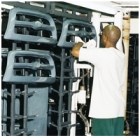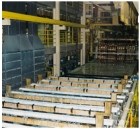Plating Plastics at Guardian Automotive Trim
Plating automotive accent pieces with a nickel-chrome finish keeps automobiles looking good...
#automotive
During the drive from Cincinnati to Evansville, Indiana, I encountered many chromium-plated parts. Shiny chromium-plated semi-truck grilles closing in on my chromium-plated pickup truck bumper. Big bright wheels flying past my window at 75 mph plus. And plenty of pickup trucks with chromium-plated grilles, bumpers, side pipes and trim. Although chromium plating on automobiles declined in the 70's and 80's, for the most part trucks have maintained their chromium-plated accents, which has helped Guardian Automotive Trim stay busy and profitable.
The decline in chromium-plated automotive parts did not seriously affect Guardian Automotive Trim for two reasons: 1) It plated a lot of truck parts; and 2) It also plated appliance parts, such as Hamilton Beach blender bases and microwave oven doors. However, Randy Horn, assistant plating superintendent, has seen a growth in chromium-plated automotive and truck parts in the past three to four years. "Often vehicles are originally designed with a high-gloss painted front end," explained Mr. Horn, "but the designers ask us to chromium plate a grille as a prototype. Next thing you know, they change the design and use chromium."
Featured Content
Now Guardian's major customer is the automotive industry. It plates plastic truck grilles, mirrors, trim and interior parts such as door handles. "A bad dip in the automotive industry today would affect us," said Mr. Horn.
Although Guardian plates both interior and exterior plastic parts, it uses the same process for plating both types. "We thought about changing cycles to fit in a process for plating plastic interior parts," said Mr. Horn, "but the plastic plating process is critical at the duplex nickel and chromium stages. If you don't keep the surface precise, you run into problems." Installing a specific interior plastic nickel-chromium plating process would also slow the entire plating line because of the shorter cycle times and the subsequent scheduling difficulties. Guardian decided that this would create more problems than it was worth and kept its already successful process in place.
Guardian plates ABS plastic, polycarbonate ABS and other polycarbonate blends; however it prefers plating on pure ABS. The reason is that ABS has many butadiene rubber particles uniformly distributed throughout the plastic. Etching leaves chemically active, minute holes in the plastic that provide sites for absorption of a catalyst. Basically, it is easier to plate.
During the activation step, the tin-palladium catalyst is absorbed onto the etched surface. Parts are rinsed, leaving metallic palladium sites surrounded by hydrolyzed tin hydroxide. The excess tin hydroxide is removed using an acid dip, leaving the palladium to act as a catalyst when the parts are submerged in the electroless-nickel-plating tank.
The plastic blends are more expensive and difficult to plate because they have less butadiene, but many automotive engineers prefer the higher-impact polycarbonate blends. During testing, the shock-absorbent area of the polycarbonate blend withstands a greater impact, but in the real world, according to Mr. Horn, it does not absorb that much. "At 40 to 50 mph impact, the type of plastic does not make much of a difference," he commented. You can mold a part using PC ABS for strength or reinforce a part made from ABS. The molding process is critical, because any imperfections due to molding are magnified by plating. Much of a part's performance depends on the part design. Guardian works with automotive design engineers to develop parts; however, most of the cooperative engineering is done at the Guardian Tech Center in Warren, Michigan.
Once parts are molded, they are masked. During this process, the parts are placed in masking systems from Rodgers Finishing Tools and sprayed with resist paint in a spray booth from George Koch Sons, LLC. After air drying, the parts are taken to the plating line.
Because of the different plastics, Guardian has several etching options. Parts molded from blends that have a lot of polycarbonate (hence less butadiene) go through a pre-etch system. For lighter grades of polycarbonate/ABS blends, the normal etching tank is adjusted by raising the temperature and increasing the concentration. All plating chemicals are supplied by Enthone Inc.-OMI. Table I shows the electroplating process parameters beginning with the etching cycle.
As each rack of parts finishes its plating cycle, it goes through a series of hot and cold rinses to test for adhesion. The plastic and the plating expand and contract at different rates. The hot-cold-hot sequence reveals adhesion failure before parts leave the line.
Presently, Guardian uses electroless nickel, but electroless copper plating may be added to the line because of customer specifications. Guardian already has the capacity to plate electroless copper (the tanks, etc. are established). One reason customers specify electroless copper is because copper is more ductile than chromium. Therefore, it provides greater flexibility in the field. One reservation Guardian has about electroless copper plating is that it is harder to control. However, Jim Martin, electroplating superintendent, noted, "Once you start plating electroless copper and you become familiar with it, it isn't so difficult to control."
The lab at Guardian runs continuous titration checks on the baths and preplate solutions during all three shifts. Guardian operates 24 hours a day six to seven days a week. The lab is also equipped for Hull cell testing, thickness testing and chemical analysis. The automatic feed system operates according to square footage. The feeders cycle on and off for a few seconds after so much square footage has been processed.
The copper plating baths are batch carbon treated every four months. This includes removing and cleaning the anodes and stripping and cleaning the tank. The same is done every six months to the nickel-plating bath. The duplex nickel plating bath is carbon treated every four weeks. Rinses are dumped weekly. This strict regiment helps maintain quality, particularly since brighteners have breakdown products that can create stress in the baths.
With two former EPA employees on staff, Guardian understandably takes waste treatment seriously, and it has won several environmental awards from the state. Water is recycled back to the non-critical baths as much as possible. Evaporators run on the chromium plating tanks and etch tanks. Guardian uses approximately 30 to 40 million gallons of water a year; therefore, its waste treatment system is sizable. The system is sized for twice the volume it currently handles so that Guardian can expand without worrying about waste treatment capacity.
In preparation for growth, Guardian is currently refurbishing critical areas of the line, such as the hoists. It is also upgrading controllers and placing new PCs on the line. Although its current on-line computer is Y2K compliant, it needs chips replaced in the systems. The computers control the plating line's dynamic scheduling. This "recipe-specific" system optimizes efficiency. Because of its flexibility, as compared to a fixed timeway system, Guardian can run different plastics and different cycles at the same time. This makes better use of the equipment, saving on wear and tear.
Plastic plating is an area of growth, and Guardian plans to expand to meet the demand. Its plan includes either another plating line or additional tanks on the existing line. Guardian has set the standard in both plating processes and product quality, ensuring that its automotive customers receive the highest quality plated plastic products.
| TABLE I—Electroplating Process Parameters | ||||
| Process | Chemicals | Temp. (F) | Time Min. | Time Max. |
| Etch | Chromic acid Sulfuric acid Trivalent Cr |
156 | 600 sec | 660 sec |
| Neutralizer | Hydrochloric acid | 83 | 72 sec | 100 sec |
| Pre-dip | Hydrochloric acid | Ambient | 100 sec | 200 sec |
| Activator | Hydrochloric acid Sodium chloride |
83 | 160 sec | 180 sec |
| Accelerator | Sodium chloride | 135 | 115 sec | 120 sec |
| Electroless Nickel | Ammonia | 93 | 500 sec | 530 sec |
| Nickel Activator | Sulfuric acid | Ambient | 45 sec | 90 sec |
| Copper Immersion | Copper sulfate Sulfuric acid |
80 | 130 sec | 200 sec |
| Copper Strike | Copper sulfate Sulfuric acid Hydrochloric acid |
80 | 430 sec | 540 sec |
| Acid Copper | Copper sulfate Sulfuric acid |
71 | 2,410 sec | 2,600 sec |
| Copper Activator | Sulfuric acid Peroxide |
86 | 105 sec | 150 sec |
| Semi-bright Nickel | Nickel sulfate Nickel chloride Boric acid |
138 | 2,680 sec | 2,900 sec |
| Bright Nickel | Nickel sulfate Nickel chloride Boric |
132 | 840 sec | 880 sec |
| Duplex Nickel | Nickel sulfate Nickel chloride Boric |
142 | 145 sec | 249 sec |
| Chromium Rinse | Chromic acid | Ambient | 50 sec | 60 sec |
| Chromium | Chromic acid Sulfuric acid Fluoride |
112 | 120 sec | 280 sec |
| Hot Rinse | DI | |||
| Cold Spray Rinse | DI | |||
| Hot Rinse | DI | |||
To learn more visit Enthone Inc. and George Koch Sons, LLC.
RELATED CONTENT
-
Blackening of Ferrous Metals
The reasons for installing an in-house cold blackening system are many and varied.
-
Aluminum Anodizing
Types of anodizing, processes, equipment selection and tank construction.
-
Masking for Surface Finishing
Masking is employed in most any metal finishing operation where only a specifically defined area of the surface of a part must be exposed to a process. Conversely, masking may be employed on a surface where treatment is either not required or must be avoided. This article covers the many aspects of masking for metal finishing, including applications, methods and the various types of masking employed.





















